This is all about SAP cloud computing.
You’ll learn:
- Cloud computing in a nutshell
- SAP jumped on the cloud computing bandwagon
- SAP’s cloud computing services
- Lots more
So if you’re into SAP cloud computing, this is the article for you!
Let’s dive right in!
What Is SAP Cloud Computing?
The software business is about providing solutions in an ever-evolving landscape of problems. What’s optimized now may not be so next week.
For this reason, enhancements and innovations, as well as bug fixes and security patches, need to be delivered to customers as quickly as possible—which is why the cloud has become so important.
With cloud computing, you can deliver applications wirelessly, and you can push optimizations to customers instantly. Employing the cloud provides more excellent value for customers and has vastly improved the customer service experience.
What’s more, the cloud has forever changed the way software companies do business. For companies facing security threats, the cloud has provided real-time solutions. For those who rely on analytics to remain competitive, there are increasingly powerful solutions.
SAP cloud is a collection of products that provide cloud solutions, encouraging businesses to transition from their on-premise landscapes to cloud-based ones. Within the SAP cloud, you’ll find a long list of solutions with potential enhancements and improvements for every type of business.
That said, let’s take a brief look at SAP and some of the cloud solutions the company has to offer:
A Brief Look at SAP
More than 90% of companies already use cloud computing. SAP eventually gave in and jumped into the cloud computing game too with full force. It’s time for full-fledged SAP cloud computing.
Cloud computing spending has climbed from $67 billion in 2015 to $117 billion in 2018—almost doubling in just four years.
Therefore, it was high time SAP joined the cloud computing train!
SAP took cloud computing action in the early 2010s, SAP saw the expansion of cloud-based solutions as the future of business and turned its focus to the cloud. With the acquisition of several companies already innovating in the cloud, SAP was able to develop robust solutions.
After acquiring SuccessFactors, Ariba, and Concur Technologies, SAP partnered with IBM to sell cloud-based services. SAP also partnered with HPE to provide secure hybrid offerings until the SAP S/4HANA was released in 2016.
Most of SAP’s SaaSs are from companies that SAP bought.
In 2017, SAP HANA Cloud Platform was rebranded to SAP Cloud Platform. Three years later, in 2020, SAP rebranded its SAP Cloud Platform into SAP Business Technology Platform.
SAP cloud applications has become an integral part of businesses across the globe, with some of the most comprehensive cloud application offerings on the market.
Do you know Star Trek? If so, keep reading, otherwise, skip the next paragraph.
SAP’s cloud computing acquisitions are like Borgs: “We are the Borg. Lower your shields and surrender your ships. We will add your biological and technological distinctiveness to our own. Your culture will adapt to service us.”—haha.
SAP bought these companies to assimilate their SaaSs:
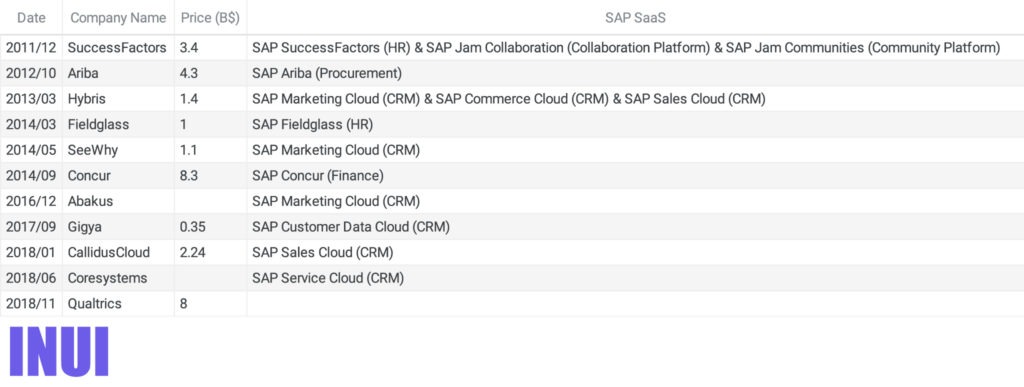
Right now, SAP needs to integrate all those cloud applications that they’ve bought from different providers into the SAP landscape and into each other so end users and super users can have a consistent experience.
Here’s the complete list of SAP SaaSs (SaaS, PaaS, and IaaS are described below):
- SAP S/4HANA Cloud (ERP for medium and large companies)
- SAP Business ByDesign (ERP for medium companies)
- SAP Business One (ERP for small companies)
- SAP S/4HANA Finance (Finance)
- SAP Concur (Finance)
- SAP Ariba (Procurement)
- Human Capital Management (HR)
- SAP Fieldglass (HR)
- SAP SuccessFactors (HR)
- SAP Analytics Cloud (BI)
- SAP Integrated Business Planning (Logistics)
- SAP Jam Collaboration (Collaboration Platform)
- SAP Jam Communities (Community Platform)
- SAP Marketing Cloud (CRM)
- SAP Commerce Cloud (CRM)
- SAP Customer Data Cloud (CRM)
- SAP Sales Cloud (CRM)
- SAP Service Cloud (CRM)
Salesforce is a prime example (and SAP’s #1 rival in CRM) of a cloud computing company’s success in CRM (Customer Relationship Management).
Salesforce provides CRM software as a cloud computing service and has done so since 1999.
Salesforce has become the leader in CRM software thanks to the cloud. It also became the market leader by a wide margin.
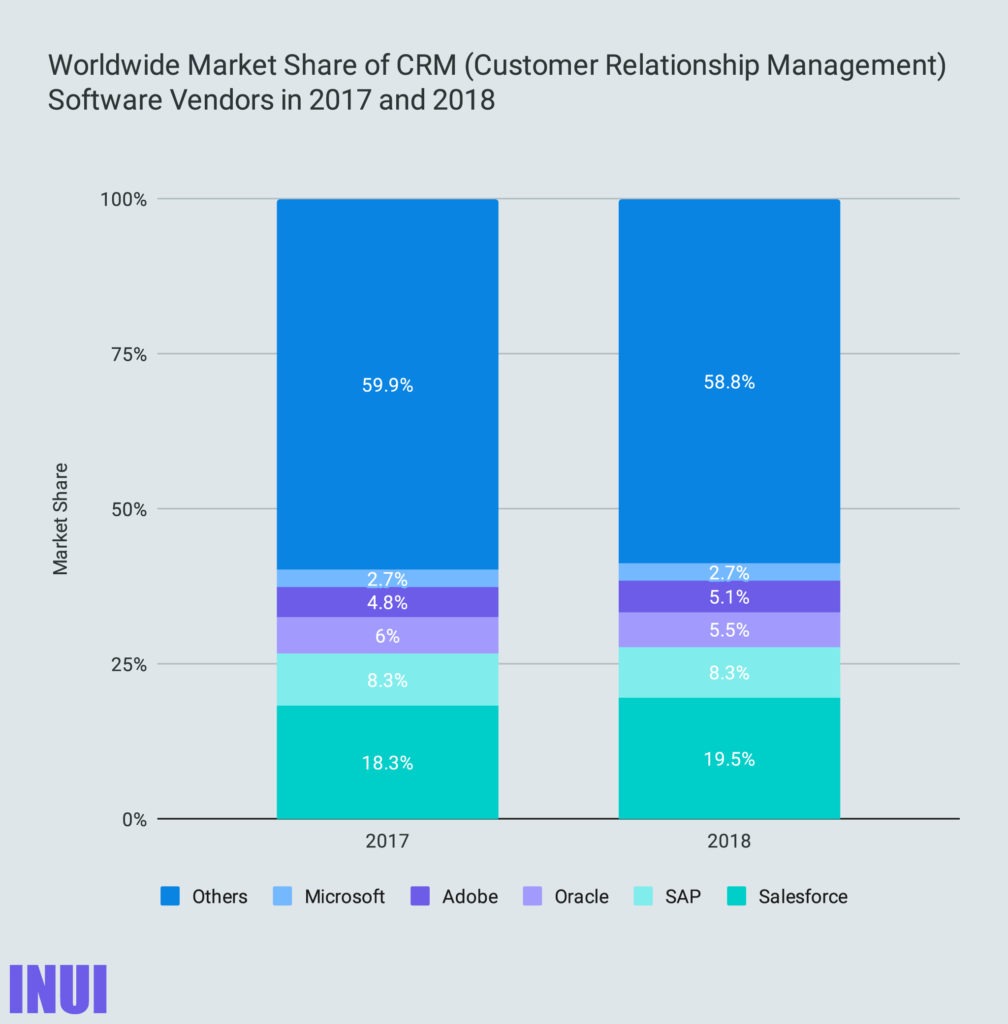
CRM has been Salesforce’s only ERP area so far. Who knows what else they would be good at if they didn’t limit themselves to CRM.
Anyway, what exactly is cloud computing?
How Cloud Computing Solutions Work
For many businesses, cloud solutions have a lot to offer. Not only do they cut back on the need for in-home IT infrastructure, but they help to relieve many administrative responsibilities, including security.
That said, for companies that have invested in on-premise applications, such as Business Warehouse (BW) and Enterprise Resource Planning (ERP), the prospect of moving these critical applications to the cloud may seem monumental. To cover the requirements, a broad range of cloud solutions is needed, such as:
- SaaS (Software as a Service): SaaS is a delivery model in which software is licensed on a subscription basis and hosting by the company. For those who prefer to get started in the cloud as quickly as possible, these types of cloud solutions may be the way to go. They include standard business applications focused on procurement, finance, HR, etc.
- IaaS (Infrastructure as a Service): Iaap solutions provide an underlying network infrastructure like physical computing resources, location, data partitioning, scaling, security, backup etc. They are ready for use but offer more customization and control than SaaS solutions do. For businesses already running on-premise platforms, IaaS solutions offer a privately managed cloud environment for your business.
- PaaS (Platform as a Service): PaaS solutions are those that provide a platform within the cloud where applications can be developed, managed, and run without having to maintain your own physical infrastructure. So, for customers that prefer to build and run custom cloud applications designed to extend the functionality of on-premise systems, PaaS cloud solutions are available.
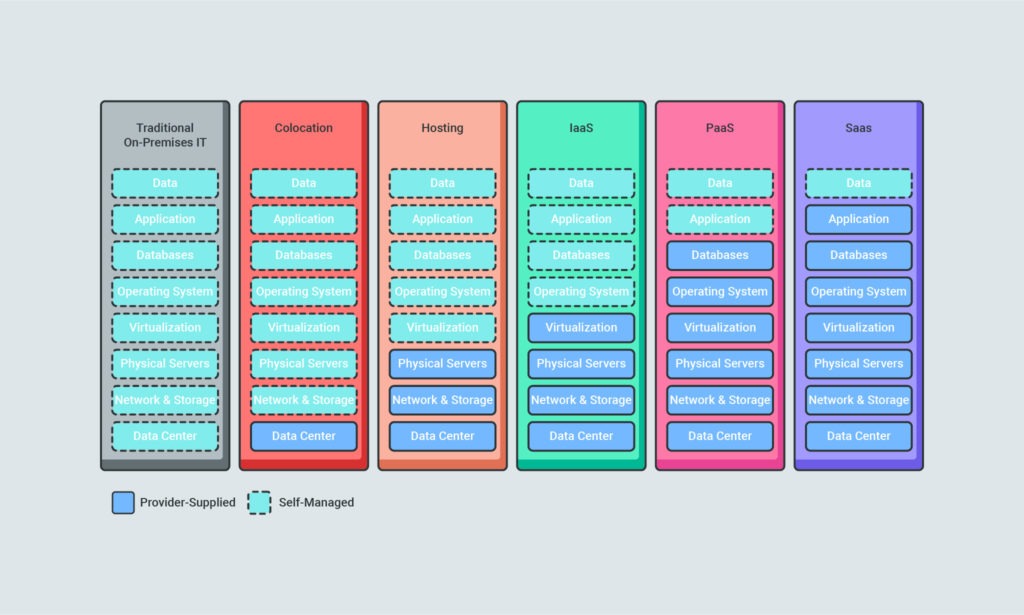
Almost any cloud solution falls into one of the three categories above. Of course, within each one is an assortment of applications and services designed to fit individualized needs.
For most businesses, it’s critical to find solutions that ensure an integrated and unified cloud environment. For this reason, SAP cloud includes offerings in all of the above categories run on one common cloud infrastructure.
5 Ways Cloud Solutions Improve Business
For the future of business, cloud solutions remain one of the top reasons for growth and efficiency. They allow companies to focus on core business processes without being dragged into the costly and time-consuming system backend.

Some other advantages include:
1. Improved Scalability
Many cloud solutions handle backend problems, enabling businesses to grow without large investment costs. You can also expect additional resources to be ready should you need them at the drop of a hat.
There’s no longer the wait time associated with ordering and setting up additional hard drives or for you to set up servers in your own data center. With many cloud services, you simply put in the request for additional resources, and you can have them quickly, if not immediately. Sounds great, right?
2. Less Need for IT Infrastructure
With cloud solutions, there’s less need for internal IT infrastructure. Depending on the size of your company, you may not have the IT team capable of handling the entire backend of your system.
In fact, leasing a cloud solution may be just what your IT team needs to free them from time-consuming system maintenance. Return their focus to the integral running and optimization of the business itself.
3. Fewer Administrative Responsibilities
Similar to less need for IT infrastructure, cloud solutions also often handle general maintenance issues, such as security updates. In this way, data, tools, and services can be easily deployed and accessed without the need for as much administrative organization.
You also have access to innovation you wouldn’t have otherwise, with new releases accessible to you as soon as they become available. You can make updates without administrative headaches and with customer feedback as the cornerstone.
4. Faster Deployment
New applications can be deployed far faster using cloud solutions than in the old days of involving physical drives that had to be shipped and administered. Plus, a mobile user experience means a lot less training.
With cloud solutions, you can expect agile deployment, integration, and configuration. In other words, solutions reach users’ hands much faster than they would without the cloud. There are no lengthy upgrade cycles, faster adoption, and rapid process configuration. Who could ask for more?
5. Saves Time and Money
It’s easy to see how companies save time and money by utilizing SaaS solutions as they are much faster to deploy and implement than on-premise versions. Then, as new functionality and optimizations become available to the software, cloud customers receive them instantly.
In other words, it saves time and money to receive improvements via the internet than a physical drive. Many integrations are packaged with lower initial deployment fees and no maintenance or upgrade costs.
Pros and Cons of Cloud Solutions
At the end of the day, expect to see a significant shift to cloud solutions for businesses in the coming years. For many companies, these solutions will help to maintain efficiency and stay competitive. However, they can be unappealing for companies that prefer flexibility.
Pros
- Faster deployment
- Access to innovation, faster releases, and feedback-driven updates
- Agile deployment, integration, and configuration
- Faster upgrade cycles
- Lower TCO (Total Cost of Ownership)
- Prepackaged integrations with lower initial fees and more value
Cons
- Limits software customization options.
- The dependence on off-site tools may put off companies used to the flexibility of on-premise solutions.
- Adapting to functionality changes may require working directly with cloud solutions companies.
How SAP Cloud Computing Is Different
The bottom line is, SAP cloud computing has a vast range capability and an exceptional availability of service. SAP has the resources and the reach needed to cover a dynamic range of industries.
SAP cloud uses its industry experience and modern design paradigms to build the best cloud applications. Where most traditional IaaS vendors typically take a one-size-fits-all approach, SAP has thought about everything customers will need and how to address them.
For everything you need to set up your cloud infrastructure, SAP cloud has a solution. It has a comprehensive database of application and database services, centered around SAP HANA.
SAP HANA offers everything you need to build top-notch data-intensive applications, and SAP uses its own resources to develop many of its products. This open-source approach is crucial for companies that wish to modify and extend the functionality of their applications.
Overall, it’s a powerful platform to enlist for your business. Along with plenty of ready-made cloud solutions, your own developers are free to make customizations, providing excellent functionality. In this sense, it’s a little like the cloud platform is the playdough, and the developers are the sculptors!
SAP Business Technology Platform
SAP Business Technology Platform (formerly known as SAP Cloud Platform) is a PaaS solution and one of the foundational products within SAP cloud computing. That said, it also includes Saas and Iaas options.
The SAP Business Technology Platform was first released as SAP NetWeaver Cloud in 2012, then changed to SAP HANA Cloud in 2013, then changed to SAP Cloud Platform in 2017, and finally changed to SAP Business Technology Platform in 2020.
It’s built around a comprehensive set of seven building blocks to cover the needs of all businesses, including platform services, business services, and data and storage services. It employs an integrated network called the Cloud Connector to facilitate the exchange of information.
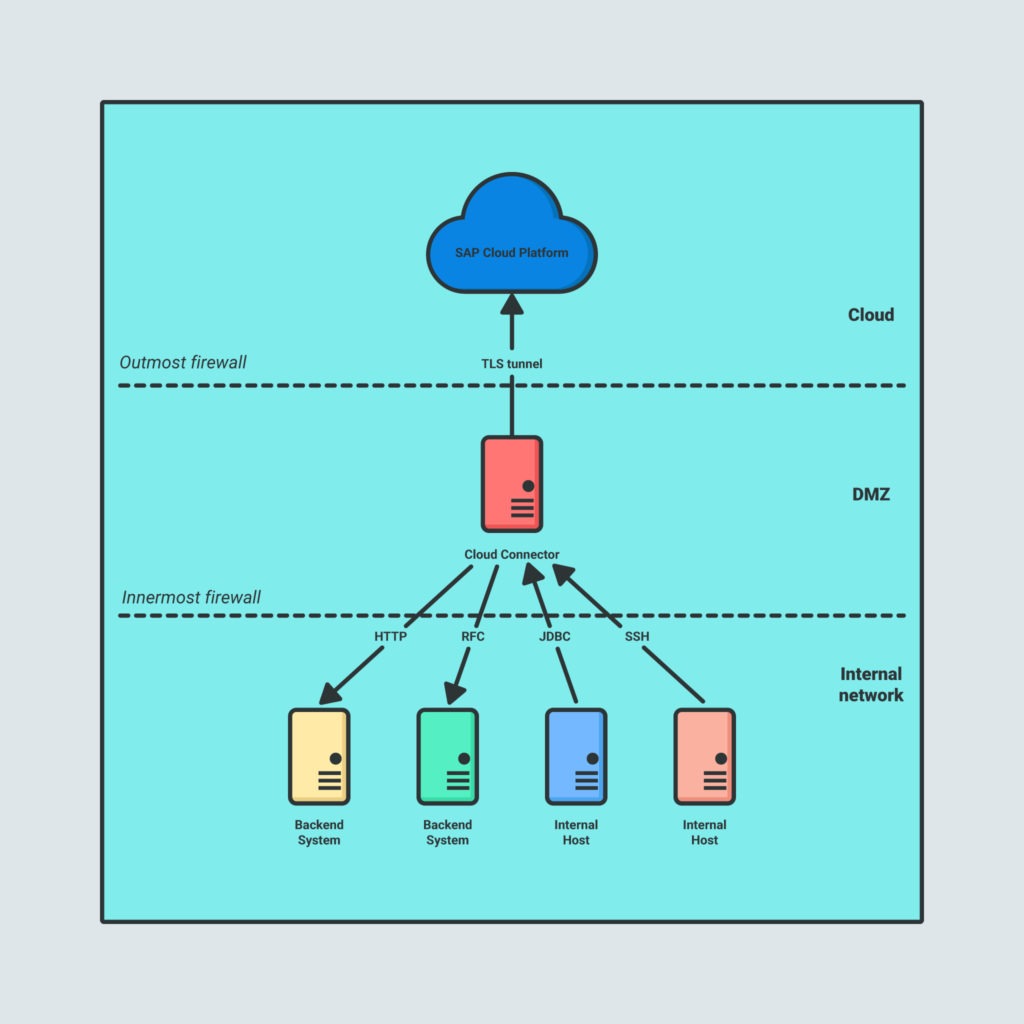
Users of the SAP Business Technology Platform can:
- Design and build custom apps and extensions to fill specific business needs.
- Provide improved database security.
- Manage data, clean it, and model it.
- Efficiently perform lower-level business processes, including taxes.
- Offer a wealth of analytics information.
- Give businesses tools for cooperation and collaboration between departments and other businesses.
- Provide a wealth of integration tools.
- Help businesses to enact processes that increase efficiency.
- Facilitate the creation of mobile-friendly services.
The SAP Business Technology Platform takes a two-pronged approach. One side of the platform focuses on providing solutions for businesses through the use of their extensive data centers. The other side offers extensibility options for developers.
Either way, SAP’s focus is on a comprehensive approach to cloud solutions, and most businesses will find their needs met and exceeded. As such, the SAP Business Technology Platform is extensive.
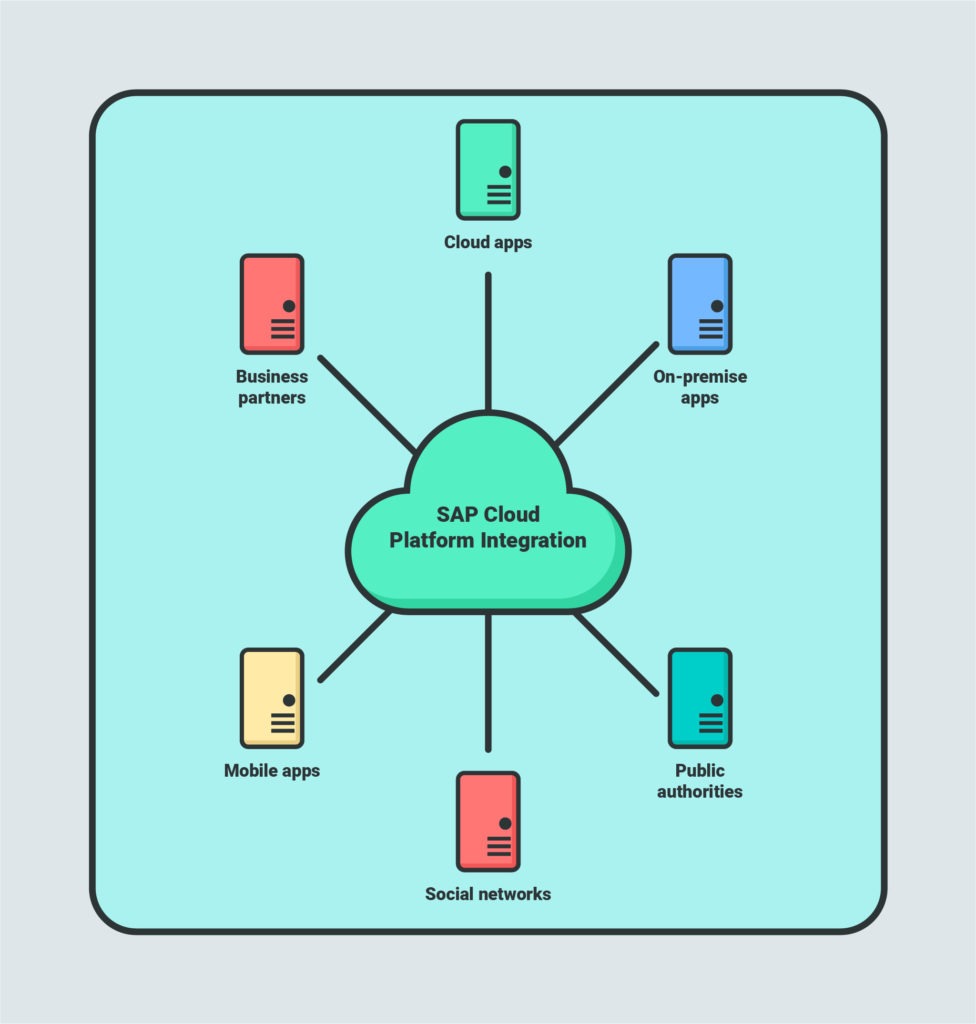
The 7 Building Blocks of SAP Business Technology Platform
As we mentioned earlier, the SAP Business Technology Platform is based on seven building blocks. Before we go any further, let’s take a closer look at each one of these building blocks and break down what they have to offer.
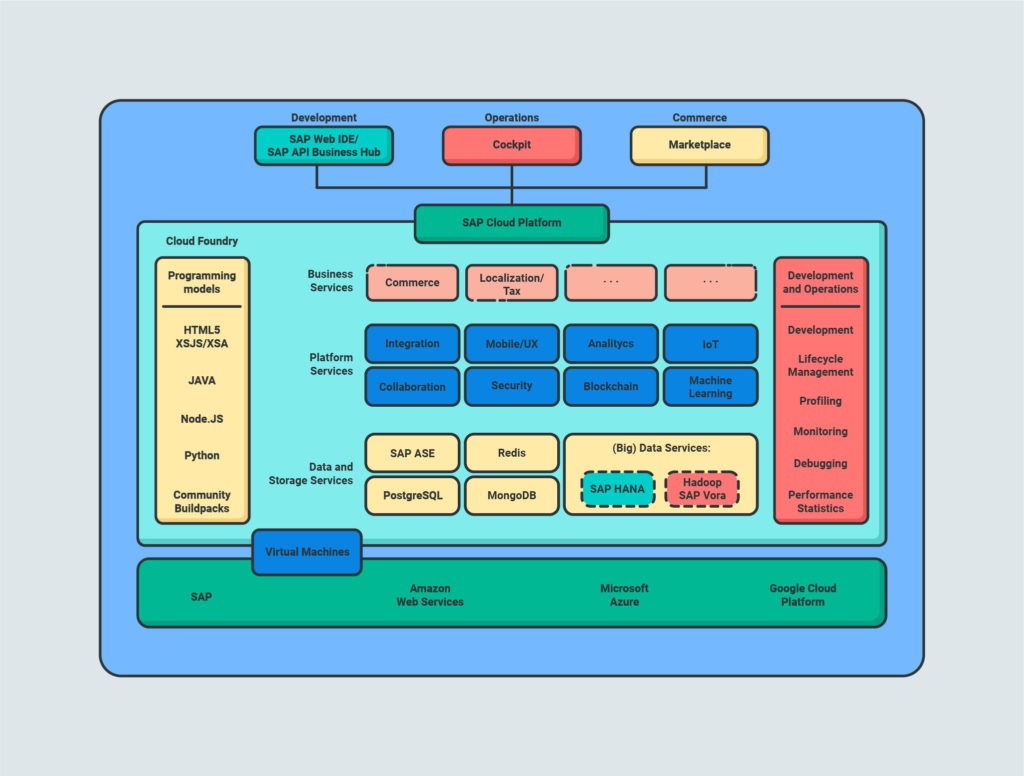
Get your thinking caps ready!
Cloud Application Program (CAP)
The SAP Cloud Application Programming model is a framework of tools, languages, and libraries that is accessible to developers. It’s a source for building services and applications for cloud-based applications.
With the CAP, developers can find out-of-the-box solutions for everyday tasks and a wealth of best application design practices. SAP CAP allows developers to use a number of different programming languages, including:
- Java
- ABAP
- Python
- PHP
- Node.js
- Groovy
- Go
- Ruby
It’s easy to find ready-made scripts for recurring functions and plenty of valuable information for those searching for innovative solutions. If you’re a developer, you’ll be happy to have the resource. If not, know that it’s an essential part of the SAP cloud community.
DevOps
Development is a large part of the SAP Business Technology Platform. As such, DevOps is a set of tools for building relationships and encouraging cooperation between developers and operations staff. DevOps is about people, processes, and organizational structure.
The goal is to optimize the end-to-end product value stream by eliminating waste and developing fast customer feedback loops. It also involves working from measurable data and sharing knowledge, success, and failure.
Business Services
A big part of SAP Business Technology Platform is its enterprise-ready capabilities. Cloud apps can be developed quickly and be ready for your business with as little hassle as possible. In addition to many ready-made solutions, SAP Cloud is designed for extensibility.
Platform Services
The SAP Business Technology Platform is designed to provide businesses with a landscape that focuses your business’s needs. From there, you can employ applications and extensions designed to optimize business processes.
In addition to ready-to-use business content, the SAP Business Technology Platform offers a set of capabilities designed to create new innovative applications in the cloud. It also offers services including mobility, machine learning, and the Internet of Things.
For instance, the Internet of Things is a capability that gathers data that you can then use to reimagine business processes. It has a reference architecture that offers business services and specific capabilities to address critical industrial use cases across manufacturing, supply chain, logistics, assets, products, service management, and more.
Data Management and Storage
SAP Business Technology Platform integrates with a number of different data management and storage services. These services are a core part of the SAP Business Technology Platform, enabling you to leverage a multi-cloud architecture if need be. You can use any of the following services:
- SAP HANA
- SAP Adaptive Server Enterprise (ASE)
- Redis
- PostgreSQL
- MongoDB
- Hadoop
- SAP Vora
Data management is an integral part of many businesses these days. As such, the SAP Business Technology Platform offers intelligent services as well to manage, connect, and process data assets across your enterprise. There are also tools to analyze and quantify data, and more.
Multi-cloud and Cloud Foundry
Another building block of the SAP Business Technology Platform is the Cloud Foundry Environment. It’s designed to enable you to develop new business applications and services. It supports multiple programming languages, runtimes, libraries, and services.
It also has tools in place to leverage a multi-cloud architecture. You can also leverage the major vendors, including Microsoft Azure, Amazon Web Services, and Google Cloud Platform.
Virtual Machines
The SAP Business Technology Platform also has virtual machines businesses can use to deploy, run, and manage their SAP Business Technology Platform structure applications. It offers virtualized hardware resources (CPU, RAM, disk space, installed OS) to ensure your application runs appropriately.
With an SAP Business Technology Platform virtual machine, you can:
- Create a virtual machine, connect to it, and manage its lifecycle.
- Configure communication to the virtual machine.
- Manage virtual machine volumes.
- Create a snapshot of a virtual machine volume.
- Consume an SAP HANA database from a virtual machine.
Overall, the SAP Business Technology Platform virtual machine is a good way to install and maintain your own applications when not covered by the platform or before they’re ready.
Cloud Solutions Offered by SAP Cloud
As we’ve mentioned, there are a lot of different cloud solutions available with SAP Cloud. Not only is the company continually developing, but it has also acquired many of the best smaller companies have to offer. Below you’ll find many of their most popular cloud solutions.
SAP S/4HANA Cloud
SAP S/4HANA Cloud was introduced in 2015 as part of SAP’s focus on cloud-based solutions. With this solution, you get access to a number of ERP cloud solutions and features.
For starters, you get embedded versions of SAP Enable Now, SAP Analytics Cloud, SAP CoPilot, and a test automation tool. You also get real-time business analytics and statistics with SAP HANA’s in-memory computing architecture.
Some of the original business areas that the project focused on included sales, supply chain and supplier relationship management, finance, HR, and R&D. Because of this, there are lots of features and documentation to support these business areas.
SAP Analytics Cloud
The SAP Analytics Cloud is a tool featuring analytics data collected from both cloud and on-premise applications. On top of predictive analytics, it also has smart assist features like data visualization, collaborations, smart insight, and more.
The SAP Analytics Cloud is one of the many capabilities of the SAP Business Technology Platform. It is capable of gathering data from across various applications.
SAP Concur
Concur is a cloud service acquired by SAP in 2014. It is a travel expense application built to manage employee travel. It tracks business-related expenses and non-compensation-based ones. You can also use it to easily reimburse employees for travel expenses and to book business travel.
SAP Ariba
Ariba is several applications for the organization and management of business purchasing. It has tools for invoice management, supplier collaboration, and spending analysis. It was acquired by SAP in 2012.
SAP CX (Customer Experience)
SAP Customer Experience (formerly SAP C/4HANA) is a collection of five applications. They include:
- SAP Sales Cloud
- SAP Service Cloud
- SAP Commerce Cloud
- SAP Marketing Cloud
- SAP Customer Data Cloud
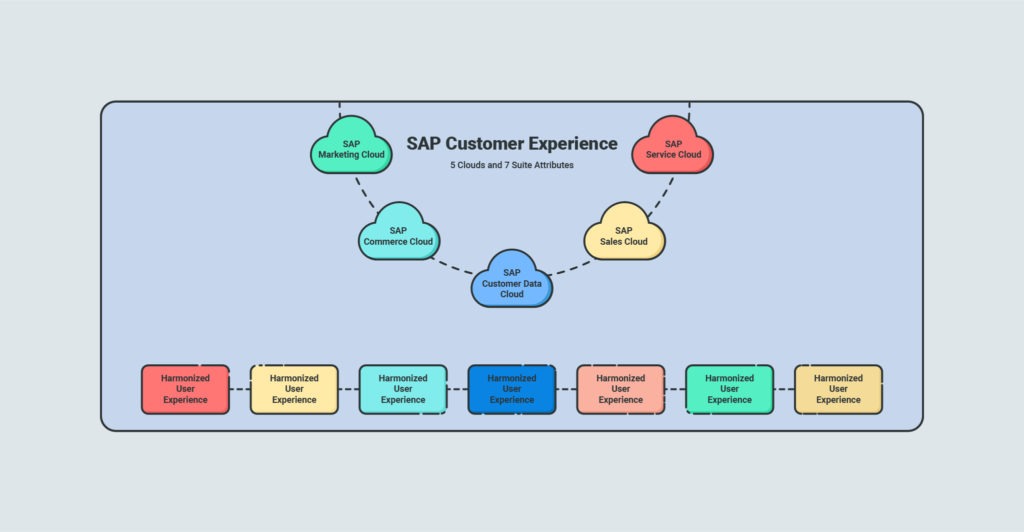
SAP Data Warehouse Cloud
For data storage, the SAP Data Warehouse Cloud is a part of the platform. It can be used solely or as part of a more extensive storage plan.
SAP Digital Manufacturing Cloud
The SAP Digital Manufacturing Cloud is a suite of applications designed to link production and business in supply chain management. They include SAP Digital Manufacturing Cloud for execution, SAP Digital Manufacturing Cloud for insights, and SAP Digital Manufacturing Network.
SAP Business ByDesign
For medium-sized companies, this cloud solution can offer enterprise resource planning (ERP) for a lot less than other programs offer it. It includes functionality for finance, human resources, customer relationship management, and project management,
Also included are procurement and supply chain management. You can even tailor it somewhat for specific industries.
SAP Intelligent Asset Management
For managing assets, the SAP Intelligent Asset Management offers five cloud-based solutions applications. They are SAP Predictive Maintenance and Service, SAP Predictive Engineering Insights, SAP Asset Intelligence Network, SAP Asset Strategy.
It also includes Performance Management and SAP Mobile Asset Management.
SAP Fieldglass
An acquisition from 2014, SAP Fieldglass is an application designed to manage temporary workers, including contract workers and temps. It’s built to help companies meet the higher than expected demands of a shifting environment.
When the employees you have are not able to complete the job, SAP Fieldglass steps in to help. Although not developed originally by SAP, it’s a powerful addition to the tools available in the SAP Business Technology Platform.
SAP Integrated Business Planning
SAP Integrated Business Planning follows the SAP Advanced Planning and Optimization application with a collection of applications built to handle supply chain management. It includes SAP IBP for operations and sales and inventory management.
What’s more, it has SAP Supply Chain Tower and applications to handle demand, response, and supply. It also has tools for demand-driven replenishment—basically, everything you need for effective business operations.
SAP HANA Enterprise Cloud
This application is for managing business operations as a whole and is built to scale as your business grows. It offers insight on how to use SAP HANA on an expert level. It’s one of the mainstays in cloud-based solutions for many companies.
SAP SuccessFactors
SAP SuccessFactors is an application for employee management on a company-wide basis. For example, it has features for training, onboarding, and recruitment. It’s a suite of tools for HR management and another acquisition of SAP in 2012.
The SAP SuccessFactors Employee Central had 3,500 customers as of the third quarter of 2019:
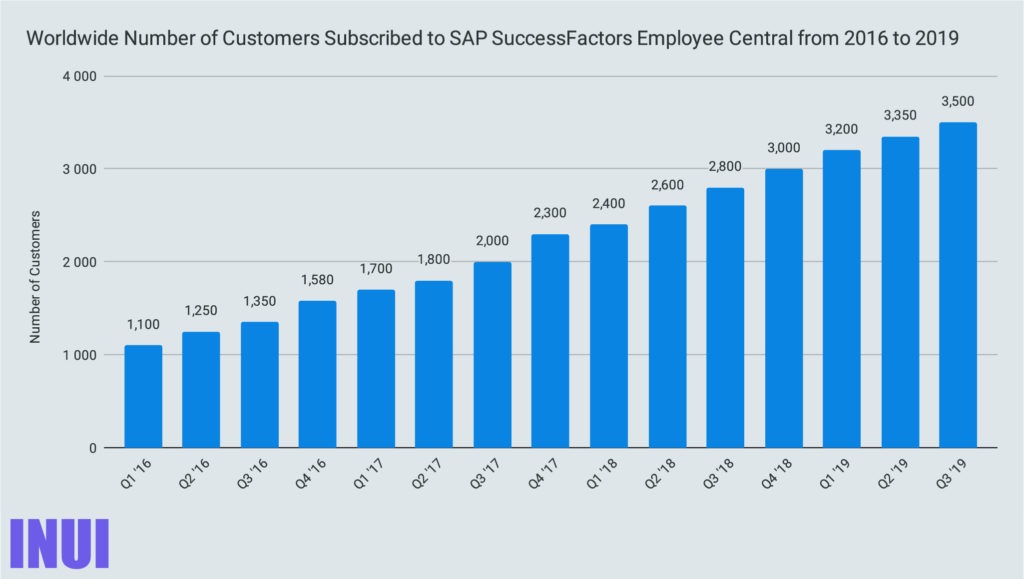
It can be observed that the customer base for SAP’s HCM (Human Capital Management) solution has steadily grown over the years.
What to Consider Before Migrating to SAP Business Technology Platform
If you’re still following along and you’ve decided to migrate to the SAP Business Technology Platform, your team and your wallet will be very happy. Doing business on the cloud reduces many operating and infrastructure costs. You may also have hardware that is nearing the end of its lifecycle, signaling it’s time to move to the cloud.
What’s more, you may be looking forward to having someone handle the maintenance for you and being able to scale up or down depending on workload needs. Plus, having access to company data from anywhere in the world is a great thing to have.
That said, before you officially make a move, there are some things you need to consider. You need to think about how much storage you’ll need and the number of resources required for your data. Let’s look at that and some other things more closely.
Choose the Right Size
For starters, you’re going to need to audit your current resources and figure out what your needs will be and how the shift to the cloud will affect everything. In general, you’ll want to make sure you have a certain amount of storage available as a buffer for computing.
Keep in mind that typical legacy databases are not compatible with cloud software. You’ll likely need to refactor the database and operating system before proceeding. Don’t let this scare you. SAP customer service can help you with this process.
Next, you’ll want to analyze your current storage for resource utilization. The results of this analysis should help you determine the cloud plan you need and that you’re ready to proceed with the migration.
Timing Your Migration
To have a successful migration, you’re going to need to devote a good portion of your time and attention to it. For this reason, timing may be an essential factor for your business. For instance, if you have a big project on the way, this could affect the outcome of the migration.
Also, bear in mind that this may not be the time for new acquisitions and rapid business growth. Once the migration is complete, you can return your focus to building the business and expansion.
Security Concerns
You might have security concerns about moving to the cloud. There is a fear that sensitive data is vulnerable in the cloud.
In fact, users of cloud technology consider “security” as the biggest challenge when it comes to using cloud computing technology:
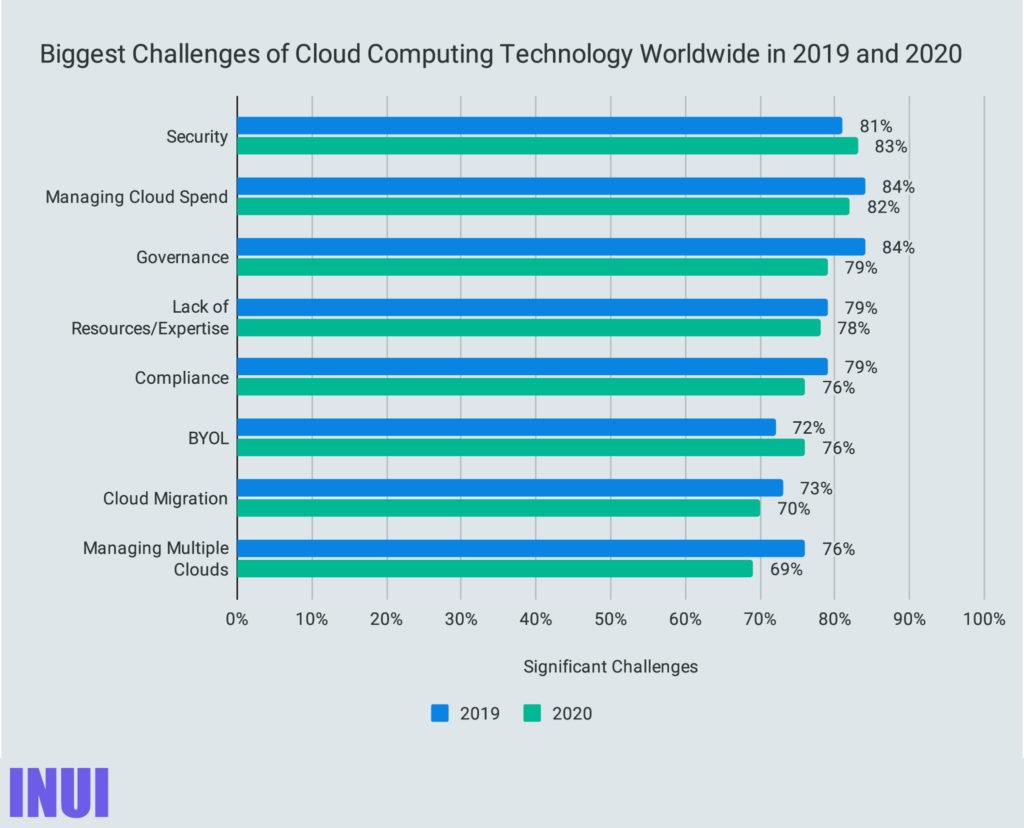
However, SAP Cloud provides a level of security that is, in many cases, far above what most companies have with on-premise applications.
If security is a concern, speak directly with someone from SAP to put your mind at ease. SAP Cloud has a number of measures put in place to prevent data theft that goes above and beyond what most companies do to guard their own servers.
Consider Latency
With some cloud systems there can be issues with latency. That is, lag times to access data and cloud applications. In general, this is caused by the place of operations being too far from the cloud data center.
In most cases, you can easily prevent latency issues by choosing the closest data center. In fact, very few businesses should struggle with this issue.
Clean Your System
Yes, now is an excellent time to get into that spring cleaning mood and clean your system. That is, to get rid of any unnecessary data and documentation. Every business, especially if it’s been around for a while, has documents stored that it no longer needs. Now is the time to clean them out.
Start by checking your system for inconsistent and corrupted files. Also, look for outdated, unreadable data formats. It’s better to clean these things out now than have to deal with them after the migration.
In this way, you can free up storage space and prevent your new system from being clogged with irrelevant data. Plus, you don’t want to unknowingly create anomalies in your new system that might require investigation only to discover wasted data.
Test Before Migrating
If you’ve prepped with an SAP representative, you should have sorted out most of the issues, but before going through with the migration, it’s best to ensure the database and system are compatible with the cloud environment.
It’s possible you may find some aspects don’t work as expected. Keep in mind that part of the migration process involves additional testing along the way. You may need to make adjustments, so don’t freak out if things come up and be prepared to handle them.
How to Implement SAP Business Technology Platform
One of the things SAP has developed for the SAP Business Technology Platform is a roadmap for implementing the cloud. For many companies, the process may seem bewildering, even overwhelming, but still necessary. For this reason, SAP Activate came to be.
What Is SAP Activate?
SAP Activate is an implementation methodology for CIOs, project managers, and SAP consultants. It provides them with the necessary tools to face any unexpected challenges that may arise as a result of moving to the SAP Business Technology Platform.
It also helps with software use and updates. SAP Activate outlines tasks and activities for companies to perform as part of the rollout process. This approach works for on-premise implementation and other SAP software.
Overall, SAP Activate is designed to conduct fit-gap analysis and uses SAP best practices to address individual companies’ unique needs. There are many SAP solutions and features ready for rapid deployment to fill functionality gaps quickly.
6 Phases of SAP Business Technology Platform Implementation
SAP Activate consists of six phases for implementation. This methodology aims to create an agile way for companies to begin using SAP Cloud applications. In addition to SAP Business Technology Platform, programs are for the following:
- SAP S/4HANA Cloud
- On-premise SAP Cloud
- SAP SuccessFactors
- SAP Ariba
For companies interested in a major migration to SAP Business Technology Platform, SAP Activate begins by offering solutions and showcasing the capabilities of SAP Business Technology Platform. From there, there is project planning and preparation, followed eventually by implementation and optimization.
SAP Activate’s six phases of implementation are:
- Discover Phase
- Prepare Phase
- Explore Phase
- Realize Phase
- Deploy Phase
- Run Phase
Overall, SAP Activate is designed to explore solutions for a company’s needs. Based on specific business scenarios, SAP Activate proposes the most relevant solutions focusing on SAP best practices.
Discover phase
To begin, SAP Activate has teams sit down and discover what SAP Business Technology Platform can do. This process involves the proposal of solutions for various business needs. While some are obvious, certain features may surprise some businesses.
This phase is about your company discovering the business value and benefits of implementing the SAP Business Technology Platform. It enables the team to define the technology architecture that best fits the needs of the business and fill those needs with cloud solutions.
Shown below are the different cloud solutions or segments of the cloud services market:
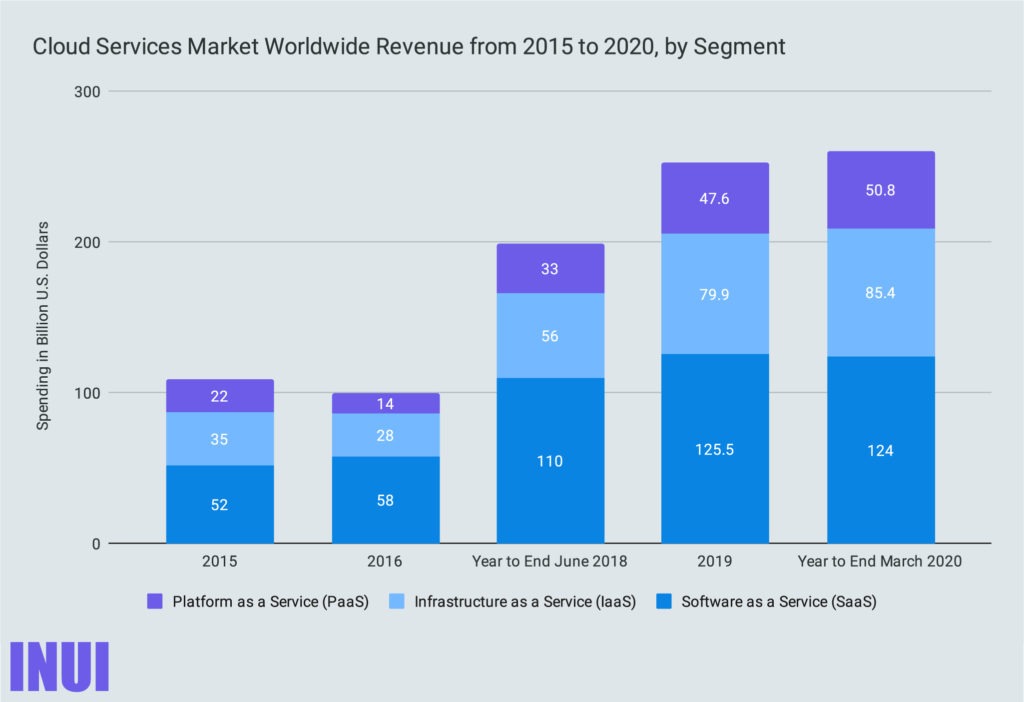
As of 2020, the largest segment is the SaaS (Software as a Service). Businesses worldwide spend around 124 billion U.S. dollars for SaaS solutions alone.
After identifying the needed solutions, the team can determine an implementation strategy. Although preparation is in the next phase, business users can begin testing cloud solution applications. Users can start with the trial versions of SAP Business Technology Platform and on-premise solutions.
After that, a digital roadmap should begin to form for implementation. The team may begin outlining a deployment strategy and is then ready for the next stage of the digital transformation journey.
Prepare phase
This phase is all about planning. This is where the project management team steps up and begins planning and preparing the initial project and giving out team assignments. From there, work can begin to ensure a successful rollout.
It’s also critical at this stage to define the project’s goals. With a shift this big, it’s important not to lose sight of why the company is making the shift to the cloud. Identifying and quantifying business objectives for implementing SAP Business Technology Platform is vital.
This stage is also where project standards are established. Like with any major business project, organization should set the key to success and set expectations for each team member. Here one should place executive sponsorship.
Finally, one should establish tracking and reporting procedures and how the project’s progress will be recorded and finalized. By the end of this phase, activate will set the project team’s roles, and responsibilities, with everyone involved ready to execute.
Explore phase
The SAP Business Technology Platform has been designed around standard business processes and SAP best practices. This phase is for business users to explore everything that SAP Business Technology Platform has to offer and come to understand how the business will proceed once fully integrated.
In this phase, the team’s responsibility is to explore how and if a standard solution meets the company’s needs or if modifications are required. In many cases, standard features prove to be the best solutions, including:
- Order-to-cash
- Procure-to-pay
- Hire-to-retire
Here business users evaluate the offerings on the SAP Business Technology Platform. Next, one should establish configurations, and business users and the SAP consulting firm should agree on the objects needed for the company and any unique configurations required.
The idea is to conduct a fit-gap exercise for each department to expose any gaps in the standard configurations. Then, solutions can be offered, and these gaps filled. This is done with business add-ins, system enhancements, and customized applications.
Additional objectives of this phase include planning the integration testing between teams and processes in a closed-loop environment. The further groundwork for SAP testing and training should also be conducted in this phase.
Finally, master data load preparation should begin. Business users should start preparing clean, correct, and comprehensive master data to be loaded into the SAP Business Technology Platform.
Realize phase
The Realize phase involves building and testing solutions, processes, and business scenarios identified in the Explore phase. Key business users will become trainers that will eventually be the ones responsible for training end-users.
At this stage, the master data is loaded into the SAP Business Technology Platform and should be rigorously tested to ensure its accuracy. The company should validate its completeness to ensure a smoother transition to actual business processes and procedures.
One should also plan end-users’ training. You should put procedures in place for how employees will learn to use the new system. SAP trainers will train employees directly to ensure a smoother transition.
Lastly, this phase involves end-to-end integration testing of all SAP components. All data and information need to be verified that it is complete and correct to ensure information flows into various components the way it should.
Deploy phase
Now, the master trainers begin the end-user training. In addition, all transitional activities will be completed in this phase. The SAP production system needs to be prepared with final master data uploads along with a number of other processes.
In this phase, uploading the cutover or the closing financial and inventory balances from the legacy systems into the SAP Business Technology Platform needs to be completed. Then, testing and validating all roles and authorizations for business users and end-users.
Business users should meet to ensure the transition to the SAP Business Technology Platform is accepted by all employees and smooth. From there, the SAP Cloud Platform goes live, and business and end-users enter the necessary data.
This stage is called the blackout period, in which data flow to the legacy systems is completely cut off. Some backlog data accumulated during the transition period may need to be entered into SAP Business Technology Platform.
Run phase
In the final phase of SAP Activate, it’s time to begin using the new system and testing for possible issues and errors. Here business users play a critical role by using the new system and reporting gaps, errors, and confusion.
To ensure a smooth transition into everyday use, it’s a good idea to establish an IT or SAP helpdesk, where your team can direct questions and issues. In this way, end users work with trainers to quickly resolve any issues faced and make necessary corrections and suggestions.
The company’s internal SAP helpdesk working with SAP consultants should be able to resolve anything that comes up. Oftentimes, incorrect entries that occur during the first few days will need to be addressed.
At the end of the Run phase, the SAP Business Technology Platform should now be an integral part of your business. With things up and running, it’s time to focus on the business itself, using your new cloud-based tools as a means for success.
